I’m extremely excited to be showing you a fully done, properly photographed, newly sewn historical outfit. It seems so long since that has happened!
Too long…
This outfit was also a long time coming. It was on my list as a wardrobe hopeful for my Fortnight in 1916 experiment, based on fashion advice articles which extolled the virtues of jumper dresses over skirts and blouses, as a wool jumper frock was more durable, and could be worn for many more days than a cotton blouse without needing washing.
I based my own ever-so-practical jumper frock on this page from The Pictoral Review Monthly Fashion Book, Dec 1915:
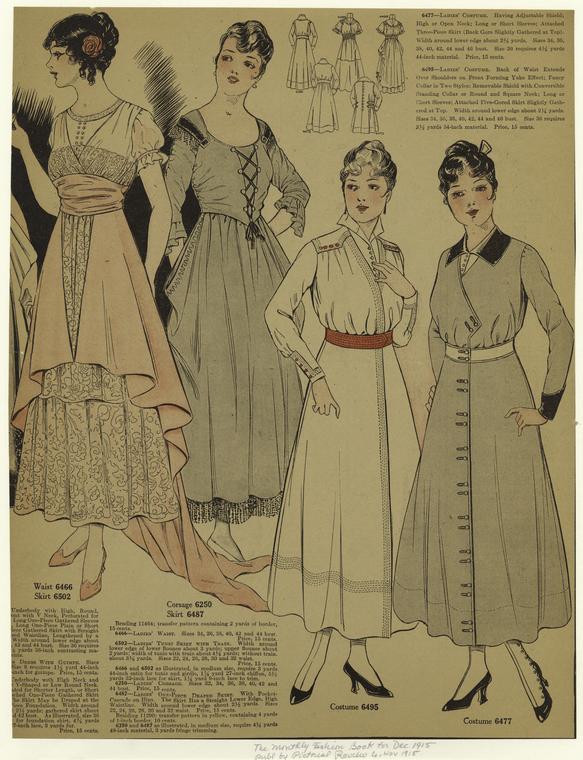 I loved the double-button detail, and the asymmetrical crossover bodice, both so typical of the mid 1910s. It just seemed to period-perfect, but also so classic.
I loved the double-button detail, and the asymmetrical crossover bodice, both so typical of the mid 1910s. It just seemed to period-perfect, but also so classic.
I also liked the severity, especially with the grey, black & white colour scheme, though the palette on these pages is so limited that it’s not the best indication of what colours the frocks would be made up in. I’m quite certain the ridiculous historicism laced-bodice number at the back was not meant to be grey!
I got the skirt part of the dress cut out and started before my Fortnight in 1916, but stashed it in the PHD pile when it became clear that I didn’t have enough prep time to make it before the experiment started, and I didn’t need to to have a complete wardrobe.
For my dress, I used the same gorgeous Tasmanian merino wool twill that I used for my Bluebell trousers (and which I still think Lynne gave me!). It looks grey in real life, but comes up very purple in photos.
Last May, while doing more research, I noticed that the pattern for my inspiration dress also appeared in the January 1916 edition of the Pictoral Review, only in black, with red touches and hidden buttons:
I really liked that this print showed it with a hat and muff, confirm it could be worn out.
(can we take a moment to swoon over the ridiculous-fabulous hat worn with the brown checked dress?)
My started dress came out in the run-up to Costume College, and with a lot of help from wonderful Wellington friends like Nina of SmashtheStash & Zara of Off-Grid Chic who came and spent a day helping me sew, and wonderful new Costume College friends like Carolyn of The Modern Mantua Maker who literally sat in a class and sewed buttons for me.
(a moment of silence and awe for how awesome these people are and how lucky I am!).
I got the dress done enough to wear at Costume College, but I wasn’t 100% happy with it. The front of the skirt was hanging slightly oddly, and the seam allowances around the armscyes weren’t finished.
So, after Costume College I did a bit of unpicking and re-jigging and got the dress just right, as a late Historical Sew Monthly July ‘Fashion Plate’ challenge, and just in time for the Sew Weekly ‘Make this Look’ challenge.
Then Mr D & I went and had fun taking photographs at the Sir Truby King gardens. We happened to be there on a house open day, but there were no volunteers around, so we didn’t go in, but he got some good photographs right in front of the house.
We only got one good photograph of the back of the dress, with the interesting collar detail that was a happy intentional accident – I split the mock-up collar to work out what to add to the curve to make it look right, and we (the amazing sewing crew) liked it so much that I incorporated that into the final collar.
In many of these photographs I’m carrying a white camellia: the symbol of the women’s suffrage movement in New Zealand.
By 1915, New Zealand women had had the vote for 22 years, but were still fighting for the right to be elected for office.
The white camellia is still a relevant symbol, because we’re still fighting for equality: a major new study has shown that sexism (not time taken for maternal leave, women’s over-representation in poorly paid industries, etc, etc.) is the main cause of the pay gap between men and women in NZ (we make 84cents to the $ in the same jobs).
Overall I’m very happy with this make. The bodice is a tiny bit long in back, and maybe a tiny, tiny bit fuller than it ought to be, but generally I really like it.
I’ll do a follow-up post next week with construction details. For now, here is the Historical Sew Monthly info:
What the item is: a 1915-16 day dress based on a Pictoral Review illustration.
The Challenge: #7 Fashion plate
Fabric/Materials: 3-4m of grey-purple Tasmanian merino wool twill (a gift), 1m of white cotton voile for the under-bodice (probably about $5), scraps of black linen (thrifted, $2 for enough to make a 1910s blouse and the collar and cuffs here, so .20cents!)
Pattern: Based on 1910s magazines, sewing books and patterns in my collection.
Year: 1915-16
Notions: cotton thread, buttons, hooks and eyes and snap fasteners,
How historically accurate is it? Quite good, though I’m not 100% convinced I got the waistband application correct.
Hours to complete: 9 of mine, another 9 from friends (have I mentioned how amazing they were?_
First worn: Costume College, Sat 29 July — not quite finished, and then again last weekend for the photoshoot.

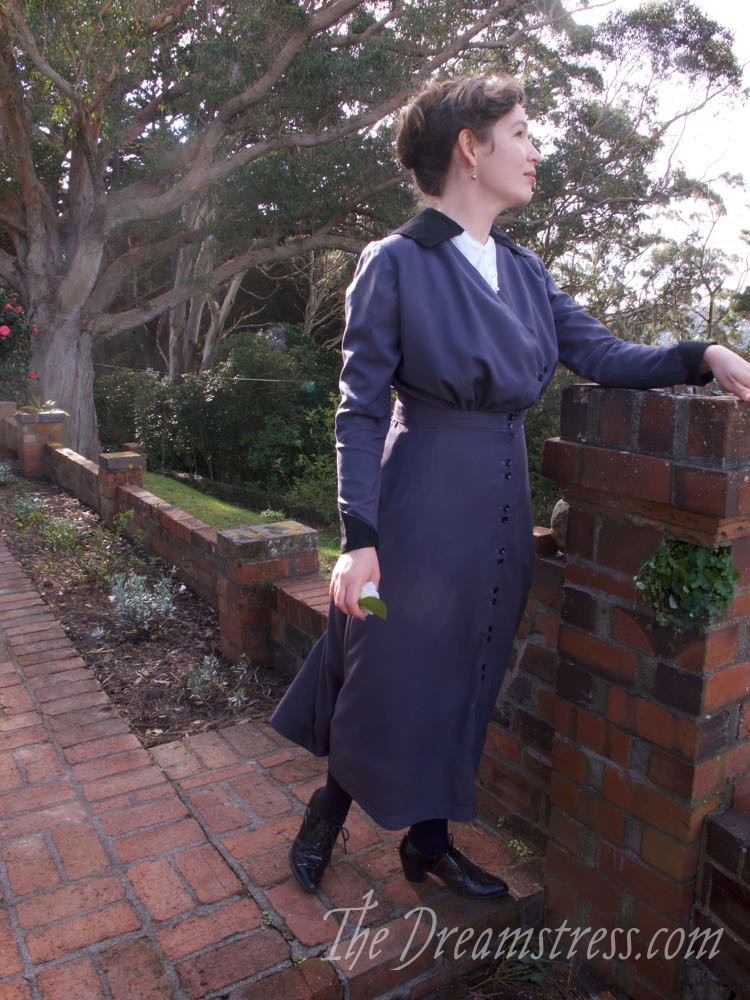
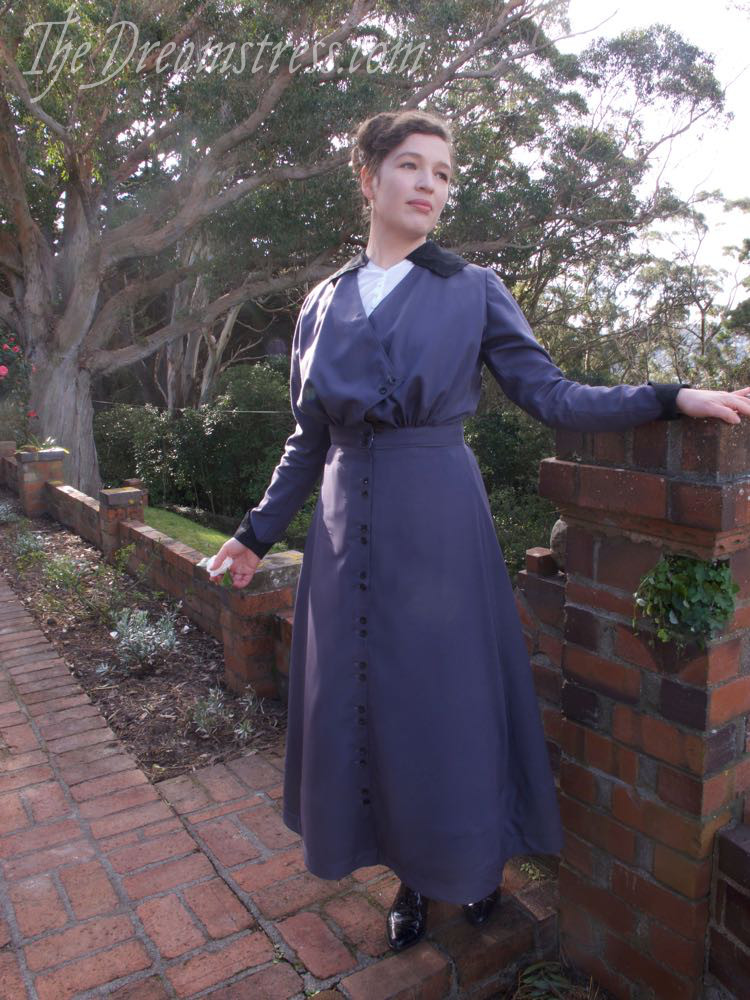


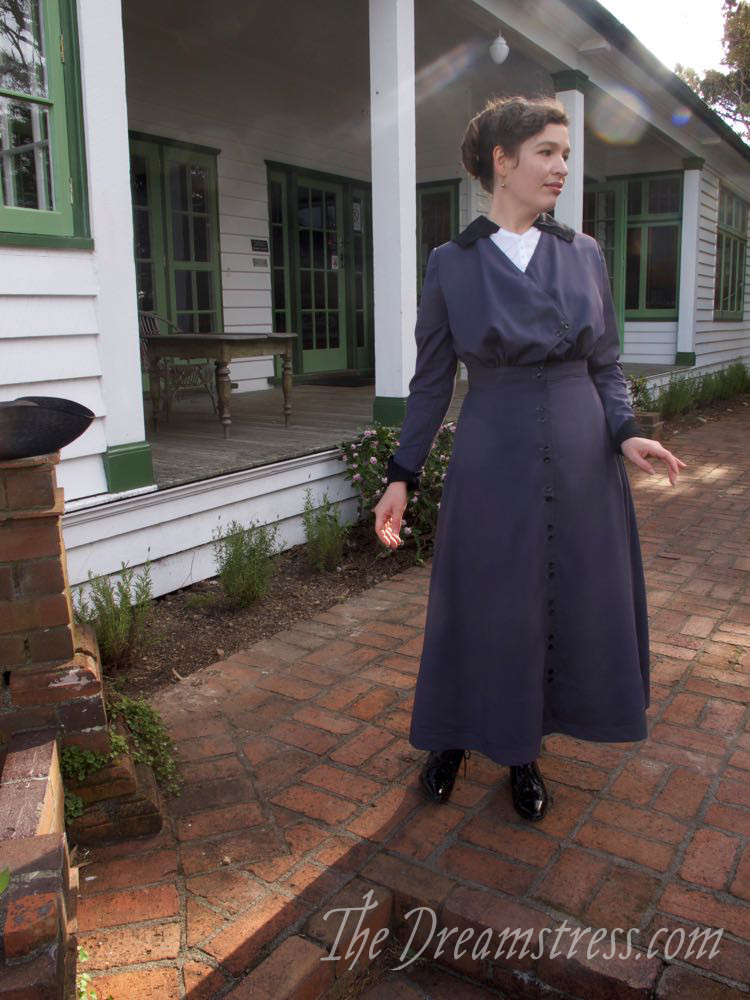
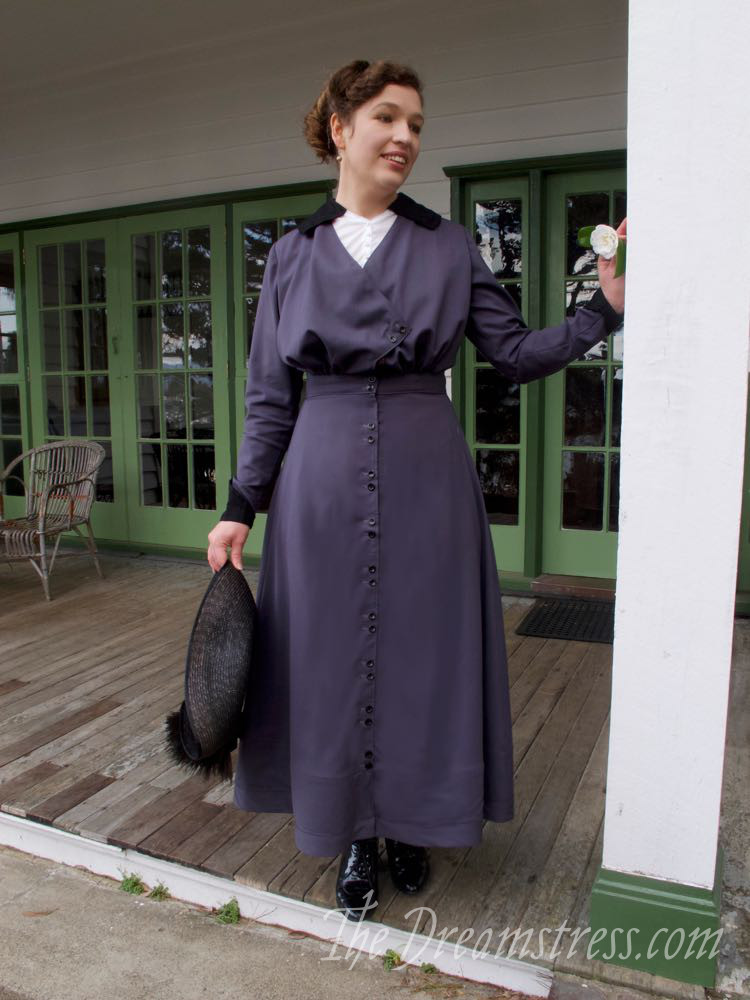
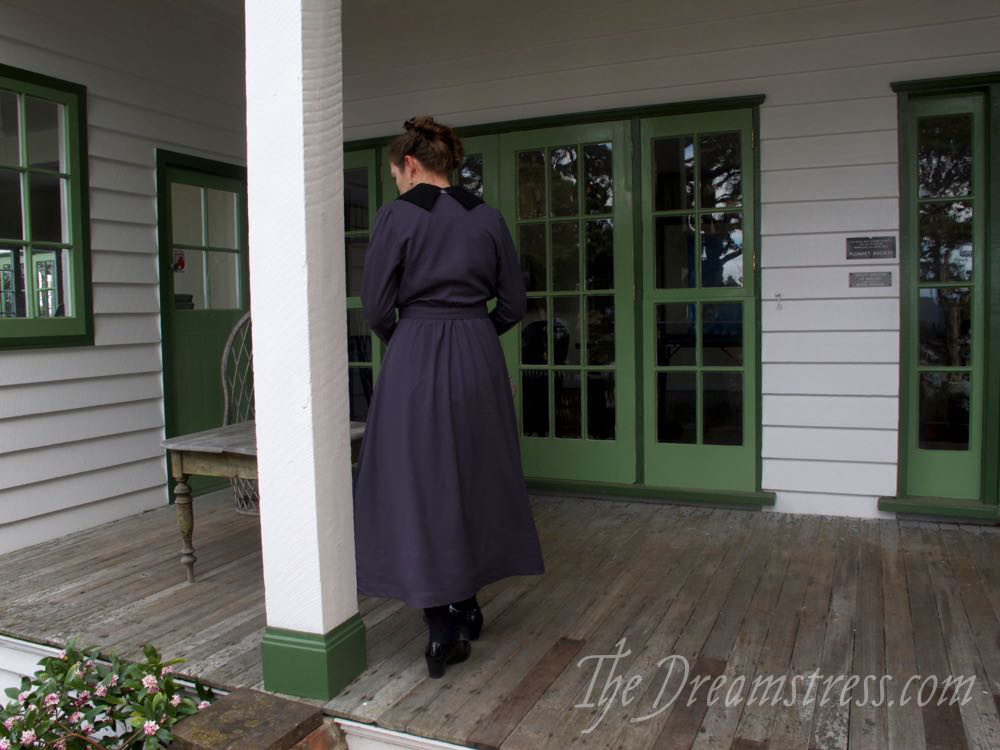
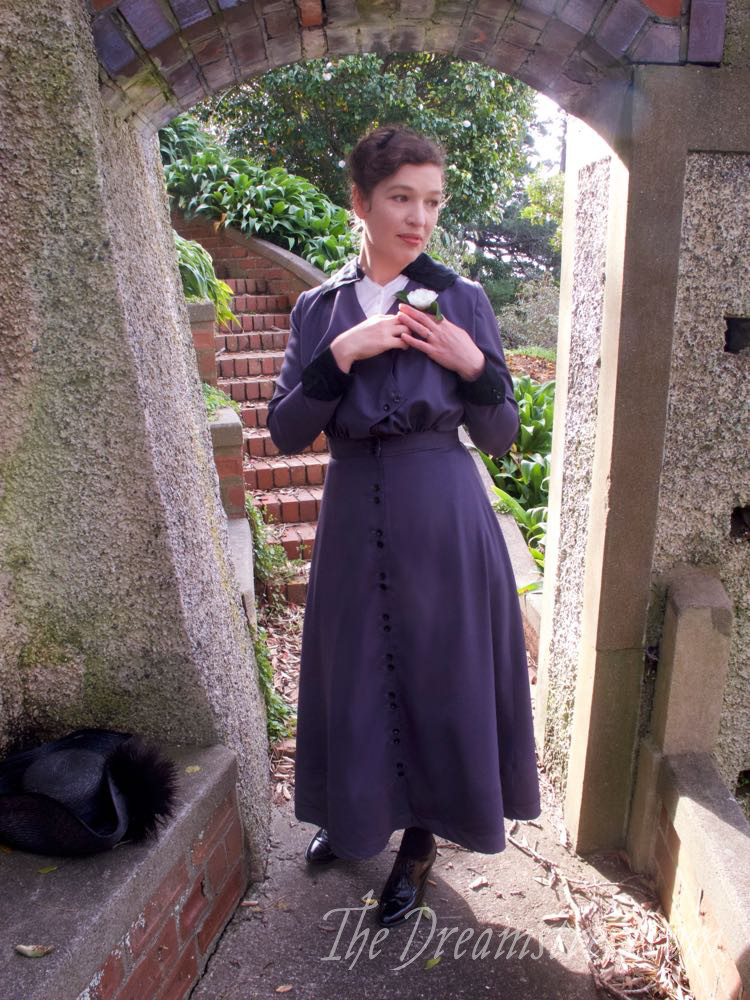
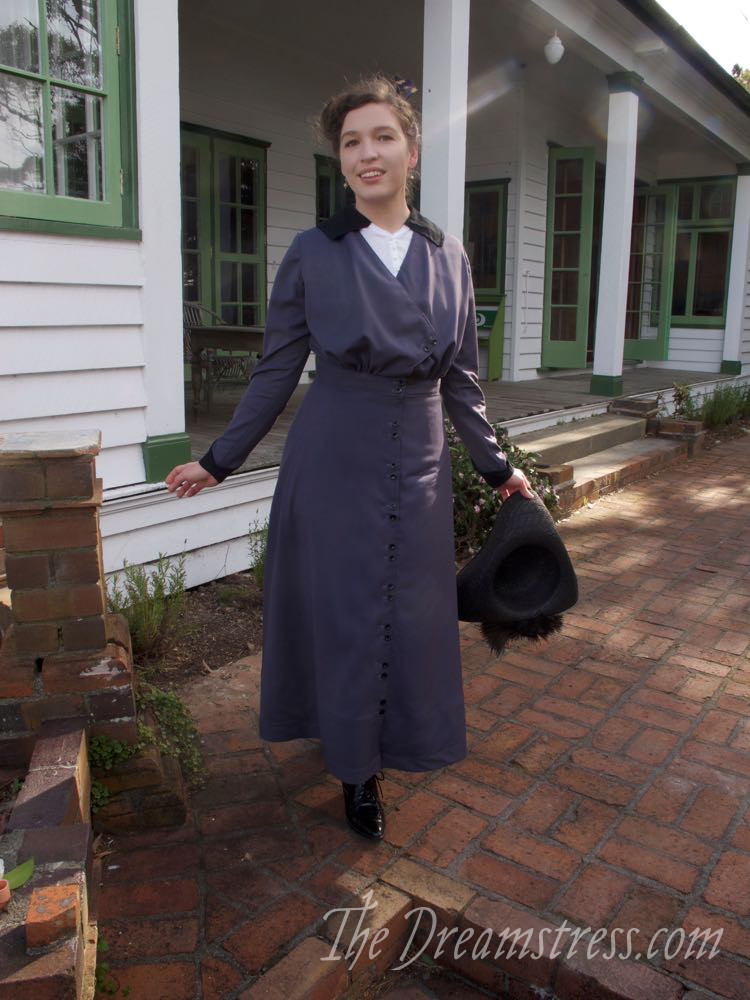
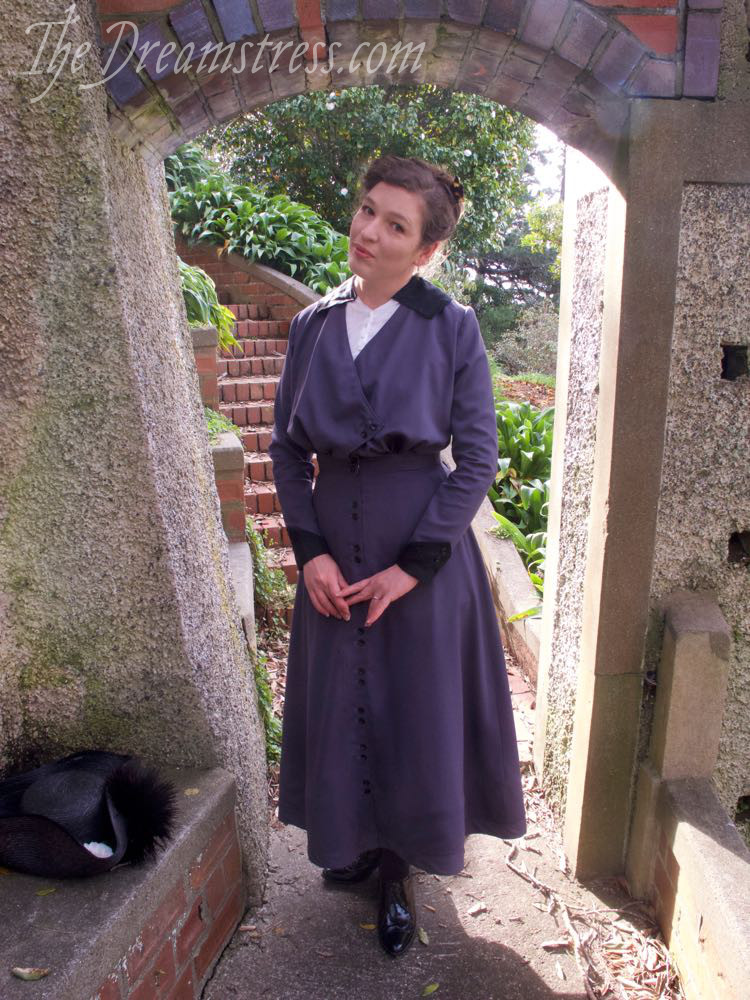
This is lovely. And classic: I could almost wear it to the office! Well done. Does it come apart so that it could be a skirt and blouse?
Thank you! No, it’s sewn together as a dress – as far as I could determine that would have been the way it was sewn in period.
Cool–thanks for clarifying.
I love it! It’s a gorgeous shape and colour.
Thank you! I’m very happy with how both came out.
I love everything about this!
Awww, thank you!
Colour me enchanted! If it is the wool I gave you, I am thrilled at the way it has turned out. This is a lovely outfit – sensible and practical, yet up for dressing up on occasion!
I’m so glad you approve! You’ve done so much to support my sewing adventures in so many ways! <3
I love it, though the bodice sags a bit oddly at center front. As you said, it’s very purple in the photographs; I’m kind of sorry it’s grayer in real life.
Thank you! Yeah, I wish I’d made it a little bit less pigeon-breast-y in front, but it was difficult to get the shape of the pattern pieces and that little jog in front to play nicely together.
I love it too!
Thank you <3
I think I would love to see a conostruction / details post of this one, because I still find myself wondering how that whole bodice works!
That split collar is a neat little detail enlivening the back; no wonder you liked it, back interest is important. 😉
I will be doing it! The bodice fastenings are pretty cool – I’m not 100% sure I got them period accurate, but they are heavily period-influenced.
Glad you like the collar! It was such a happy accident with the mock-up that we couldn’t resist keeping it!
That is a stunning dress on a very beautiful lady!
Awww, thank you on both counts! You’re too sweet <3
I love it! Not enough people do this era – I’m glad you’re into it, because I get to see your gorgeous work.
Thank you! I agree that not enough people do this era! I’m definitely not the only one though: there are a fair few other historical costumers like Wearing History and Quinn M Burgess (to name the two that came into my head first) who also do it, but it’s certainly not like the second half of the 18th century when it comes to popularity!
I’m keeping it in mind for the future; have, I think, ever since I got that old photgraph from 1917-ish.
There was also, once, a conversation I had with my sister as we looked at some pictures from 1915-1916-ish and collectively oohed over the skirt shapes…
… so, basically, once I find a good excuse to wear the clothes, I’m doing it, too.
This is gorgeous. I, too, would like to know if this is a blouse underneath or something else. Just by shortening the length to mid-calf and removing some of the fullness in the top, it would make a beautiful dress for modern wear, and I’m ready to give it a go! I see how to approach everything else, but I’m not too sure about the blouse. If you’re planning to make a Scroop pattern, I’d buy it!
Thank you! It is a separate sleeveless blouse (or, more accurately, a chemisette/guimpe) underneath. I had not planned on it being a Scroop pattern, but a LOT of people have asked, so you never know….
I’ll show more pictures of the blouse in my construction post.
Ooh I love how tailored and refined this is! So beautiful! I extra love how the buttons are grouped in pairs. The 19teens is such a fun era with all of its changes in silhouette.
Absolutely lovely Leimomi! I have just recently become fascinated with the styles of 1915-1917, so seeing your gorgeous, practical dress has spurred me to make my own (only mine will be an experiment in the maternity styles of the era).
It’s Heaven’s Grace to watch and read, that all!
No words to congratulate you!
Just thanks!!!!!
You look lovely, so well done.
Wow! Gorgeous photos and an absolutely stunning dress. It doesn’t look severe on you at all, it looks fun and rather artistic with all the clever little details. It’s the kind of garment that makes me want to learn more about the period and culture that produced it.
I look forward to reading the construction post.
Hi Leimomi. Our readers will love your latest post. Thanks for sharing. We’ve included it in our latest craft inspiration roundup. https://craftylikegranny.com/craft-creativity/ Cheers Emily
Thank you 🙂
You’re slowly turning me on to this period, your makes are so lovely!
I do really like that double button feature, and the split collar is a nice touch
Awww, thank you! It’s a great period!
As soon as I saw this I thought “Mary Poppins” ! This garment is far closer to the actual garments fictional Mary would have worn in the original book, which was set in 1910, from the Disney film costume. All you need is a parrot umbrella and you’d make a lovely Mary.